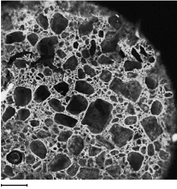In situ fabrication of macroporous polymer networks within microfluidic devices by living radical photopolymerization and leaching
Abstract
Novel fabrication techniques and polymer systems are being explored to enable mass production of low cost microfluidic devices. In this contribution we discuss a new fabrication scheme for making microfluidic devices containing porous polymer components in situ. Contact lithography, a living radical photopolymer (LRPP) system and salt leaching were used to fabricate multilayer microfluidic devices rapidly with various channel geometries and covalently attached porous polymer plugs made of various photopolymerizable substrates. LRPP systems offer the advantages of covalent attachment of microfluidic device layers and facile surface modification via grafting. Several applications of the porous plugs are also explored, including a static mixer, a high surface area-to-volume reactor and a rapidly responding hydrogel valve. Quantitative and qualitative data show an increase in mixing of a fluorescein and a water stream for channels containing porous plugs relative to channels with no porous plugs. Confocal laser scanning microscopy images demonstrate the ability to graft a functional material onto porous plug surfaces. A reaction was carried out on the grafted pore surfaces, which resulted in fluorescent labelling of the grafted material throughout the pores of the plug. Homogenous fluorescence throughout the depth of the porous plug and along pore surfaces indicated that the porous plugs were surface modified by grafting and that reactions can be carried out on the pore surfaces. Finally, porous hydrogel valves were fabricated which swelled in response to contact with various pH solutions. Results indicate that a porous hydrogel valve will swell and close more rapidly than other valve geometries made with the same polymer formulation. The LRPP-salt leaching method provides a means for rapidly incorporating porous polymer components into microfluidic devices, which can be utilized for a variety of pertinent applications upon appropriate selection of porous plug materials and surface treatments.


 Please wait while we load your content...
Please wait while we load your content...